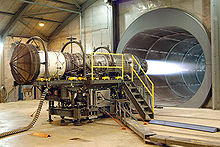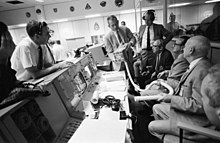Aerospace engineering
Aerospace engineering is the branch of engineering that concerns aircraft, spacecraft, and related topics. Aerospace engineering deals with craft that leave Earth's atmosphere and aeronautical engineering deals with craft that stay within Earth's atmosphere. Aerospace engineering was originally known as aeronautical engineering and dealt solely with aircraft. The broader term "aerospace engineering" has superseded the former in most usage, as flight technology advanced to include craft operating outside Earth's atmosphere.[1] In analogy with "aeronautical engineering", the branch is sometimes referred to as astronautical engineering, although this term usually only concerns craft which operate in outer space. Aerospace engineering is often informally called rocket science in common terms.

Overview
Modern flight vehicles must undergo severe conditions such as differences in atmospheric pressure and temperature, or heavy structural load applied upon vehicle components; numerous matters must be taken into account, especially during the design and manufacture of the flight vehicle. Consequently, they are usually the products of a complex synthesis of various technologies and sciences, including but not limited to aerodynamics, avionics, materials science and propulsion. The knowledge and the process of combining these various branches of studies is collectively known as aerospace engineering. This complex characteristic keeps a single aerospace engineer from involving in the entire task;[2] rather, aerospace engineering is conducted by a team of engineers, each specializing in their own branches of science. The development and manufacturing of a flight vehicle is basically a process to carefully balance and compromise between its abilities, performance, available technology and costs.
History
One person who was important in bringing up the world of aviation as we know it was the famous Alberto Santos Dumont, who came up with the first machines that were able to fly. Some of the first ideas for powered flight may have come from Leonardo da Vinci, who, although he did not build any successful models, did come up with many sketches and ideas for "flying machines".

The origin of modern-day aerospace engineering can be traced back to the aviation pioneers around the late 19th century to early 20th centuries, although the work of Sir George Cayley has recently been dated as being from the last decade of the 18th century. Early knowledge of aeronautical engineering was largely empirical with some concepts and skills imported from other branches of engineering,[3] although the early pioneers were not without theoretical background for their creations (fluid dynamics, a key branch of science related to aviation, was present from the century before). Only a decade after the successful flights by the Wright brothers, the 1910s saw extensive development of aeronautical engineering through development of World War I military aircraft. Meanwhile, research to provide fundamental background science continued by combining theoretical physics with experiments.
The first definition of aerospace engineering appeared in February 1958.[1] The definition considered the Earth's atmosphere and the outer space as a single realm, thereby encompassing both aircraft (aero) and spacecraft (space) under a newly coined word aerospace. The National Aeronautics and Space Administration was founded in 1958 as a response to the Cold War. United States aerospace engineers sent the American first satellite launched on January 31, 1958 in response the the USSR launching Sputnik.[4]
This section needs expansion. You can help by adding to it. |
Elements
Some of the elements of aerospace engineering are:[5][6]
- Fluid mechanics - the study of fluid flow around objects. Specifically aerodynamics concerning the flow of air over bodies such as wings or through objects such as wind tunnels (see also lift and aeronautics).
- Astrodynamics - the study of orbital mechanics including manipulation, determination, and prediction of orbital elements when given a select few variables. While few schools in the United States teach this at the undergraduate level, several have graduate programs covering this topic (usually in conjunction with the Physics department of said college or university).
- Statics and Dynamics (engineering mechanics) - the study of movement, forces, moments in mechanical systems.
- Mathematics - as most subjects within aerospace engineering involve equations and mathematical manipulation and derivations, a solid and comprehensive study of mathematics is required to enable effective learning in the other modules.
- Electrotechnology - the study of electronics within engineering.
- Propulsion - the energy to move a vehicle through the air (or in outer space) is provided by internal combustion engines, jet engines and turbomachinery, or rockets (see also propeller and spacecraft propulsion). A more recent addition to this module is electric propulsion.
- Control engineering - the study of mathematical modelling of the dynamic behavior of systems and designing them, usually using feedback signals, so that their dynamic behavior is desirable (stable, without large excursions, with minimum error). This applies to the dynamic behavior of aircraft, spacecraft, propulsion systems, and subsystems that exist on aerospace vehicles. As aircraft flight control systems become increasingly complex, they can be studied as a separate module.
- Aircraft structures - design of the physical configuration of the craft to withstand the forces encountered during flight. Aerospace engineering aims very much at keeping structures lightweight.
- Materials science - related to structures, aerospace engineering also studies the materials of which the aerospace structures are to be built. New materials with very specific properties are invented, or existing ones are modified to improve their performance.
- Solid mechanics - Closely related to material science is solid mechanics which deals with stress and strain analysis of the components of the vehicle. Nowadays there are several Finite Element programs such as MSC Patran/Nastran which aid engineers in the analytical process.
- Aeroelasticity - the interaction of aerodynamic forces and structural flexibility, potentially causing flutter, divergence, etc.
- Avionics - specifically concerning the design and programming of any computer systems on board an aircraft or spacecraft and the simulation of systems. Navigation equipment may be the focus of this study.
- Risk and reliability - the study of risk and reliability assessment techniques and the mathematics involved in the quantitative methods.
- Noise control - the study of the mechanics of sound transfer. Required as noise levels are a massive consideration in the current aerospace industry.
- Flight test - the discipline of designing and executing flight test programs in order to gather and analyze performance and handling qualities data in order to determine if an aircraft meets its design and performance goals and certification requirements.
The basis of most of these elements lies in theoretical mathematics, such as fluid dynamics for aerodynamics or the equations of motion for flight dynamics. However, there is also a large empirical component. Historically, this empirical component was derived from testing of scale models and prototypes, either in wind tunnels or in the free atmosphere. More recently, advances in computing have enabled the use of computational fluid dynamics to simulate the behavior of fluid, reducing time and expense spent on wind-tunnel testing.
Additionally, aerospace engineering addresses the integration of all components that constitute an aerospace vehicle (subsystems including power, communications, thermal control, life support, etc.) and its life cycle (design, temperature, pressure, radiation, velocity, life time), leading to extraordinary challenges and solutions specific to the domain of aerospace systems engineering.
Popular culture

Popular culture has not been unaffected by this branch of engineering. The term "rocket scientist" is at times used to describe a person of remarkable or in the considered context higher than average intelligence. Aerospace engineering has also been represented as the more "glittery" pinnacle of engineering. The movie Apollo 13 depicts the ground team as a group of heroes in a Hollywood fashion glorifying the intelligence and competence of white shirt and tie professionals as a sharp contrast to pop culture trends. This was later extended in more detail in the spin-off series From the Earth to the Moon.
Aerospace engineering degrees
Aerospace (or aeronautical) engineering can be studied at the advanced diploma, bachelors, masters, and Ph.D. levels in aerospace engineering departments at many universities, and in mechanical engineering departments at others. A few departments offer degrees in space-focused astronautical engineering.[6] US News and World Report ranks the aerospace engineering programs at Massachusetts Institute of Technology, Georgia Institute of Technology, and University of Michigan as the top three best of doctorate granting universities.[7] The magazine also rates Embry Riddle Aeronautical University, United States Air Force Academy, and Embry Riddle Aeronautical University in Prescott, AZ as the premier aerospace engineering programs at university that do not grant doctorate degrees.[8]
Aerospace engineers
According to the United States Department of Labor,
Aerospace engineers design, develop, and test aircraft, spacecraft, and missiles, and supervise the production of these products. Those who work with aircraft are called aeronautical engineers, and those working specifically with spacecraft are astronautical engineers. Aerospace engineers develop new technologies for use in aviation, defense systems, and space exploration, often specializing in areas such as structural design, guidance, navigation and control, instrumentation and communication, or production methods. They also may specialize in a particular type of aerospace product, such as commercial aircraft, military fighter jets, helicopters, spacecraft, or missiles and rockets, and may become experts in aerodynamics, thermodynamics, celestial mechanics, propulsion, acoustics, or guidance and control systems.
Aerospace engineers are expected to have slower-than-average growth in employment over the projection period. Although increases in the number and scope of military aerospace projects likely will generate new jobs, increased efficiency will limit the number of new jobs in the design and production of commercial aircraft. Even with slow growth, the employment outlook for aerospace engineers through 2014 appears favorable: the number of degrees granted in aerospace engineering declined for many years because of a perceived lack of opportunities in this field, and, although this trend is reversing, new graduates continue to be needed to replace aerospace engineers who retire or leave the occupation for other reasons.
— U.S. Department of Labor, Engineers[9]
Earnings for engineers vary significantly by specialty, industry, and education. Even so, as a group, engineers earn some of the highest average starting salaries among those holding bachelor’s degrees. Aerospace Engineers on average have a starting salary of $50,701 for 2005.[10]
References
- ^ a b Stanzione, Kaydon Al (1989). "Engineering". Encyclopædia Britannica. Vol. 18 (15 ed.). Chicago. pp. 563–563.
{{cite encyclopedia}}: CS1 maint: location missing publisher (link) - ^ "Career: Aerospace Engineer". Career Profiles. The Princeton Review. Retrieved 2006-10-08.
Due to the complexity of the final product, an intricate and rigid organizational structure for production has to be maintained, severely curtailing any single engineer's ability to understand his role as it relates to the final project.
- ^ Van Every, Kermit E. (1986). "Aeronautical engineering". Encyclopedia Americana. Vol. 1. Grolier Incorporated. p. 226.
- ^ http://www.hq.nasa.gov/office/pao/History/factsheet.htm
- ^ "Science: Engineering: Aerospace". Open Site. Retrieved 2006-10-08.
- ^ a b Gruntman, Mike (September 19, 2007). "The Time for Academic Departments in Astronautical Engineering". AIAA SPACE 2007 Conference & Exposition Agenda. AIAA SPACE 2007 Conference & Exposition. AIAA.
{{cite conference}}: External link in|conferenceurl=|booktitle=ignored (|book-title=suggested) (help); Unknown parameter|conferenceurl=ignored (|conference-url=suggested) (help) - ^ http://www.usnews.com/usnews/edu/college/rankings/premium/enps01.php
- ^ http://www.usnews.com/usnews/edu/college/rankings/premium/enns01.php
- ^ "Engineers". U.S. Department of Labor. Retrieved 2007-05-29.
- ^ http://money.cnn.com/2005/04/15/pf/college/starting_salaries/
